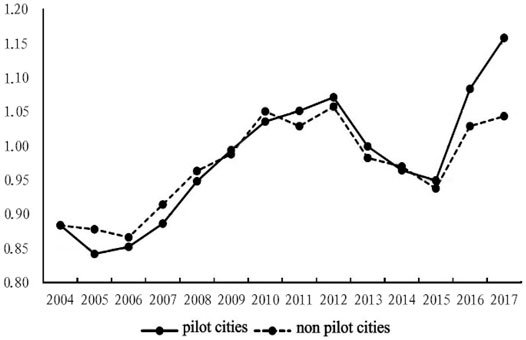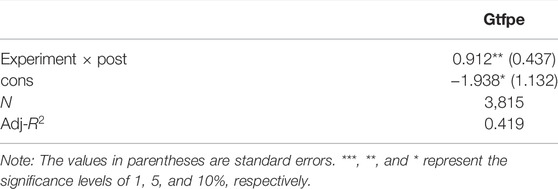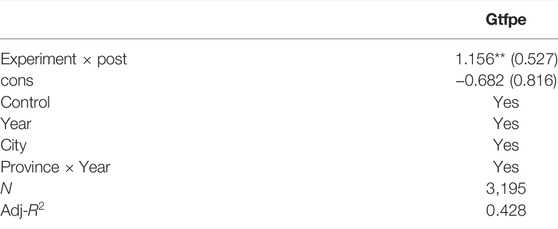- 1School of Economics, Shandong University of Technology, Zibo, China
- 2College of Economics and Management, Huazhong Agricultural University, Wuhan, China
- 3Business School, Shandong University of Technology, Zibo, China
Undoubtedly, green total factor energy efficiency plays a pivotal role in achieving energy conservation, emission reduction, and green development goals. China mainly used command-based environmental regulation tools to enhance the green total factor energy efficiency in the early stage. Later, under the new trend of market-oriented reform, the Chinese government introduced market-oriented environmental regulation tools such as carbon rights. However, the effectiveness of market-oriented environmental regulation tools is still unclear. Therefore, this study investigates the impact of market-oriented environmental regulation tools on green total factor energy efficiency by using the data of 265 cities in China. For this purpose, yearly data from 2003 to 2017 are employed using the difference-in-difference method. The empirical results unveil that the emission trading system can significantly improve green all factor energy efficiency. In addition, the heterogeneity analysis shows that the emission trading system is conducive to improving energy efficiency in resource-based cities. Based on the results, this study provides policy enlightenment for market-oriented environmental regulation tools to promote green development according to the local conditions.
1 Introduction
Improving green total factor energy efficiency is an important issue that needs to be solved urgently to realize green development in China’s economy from the stage of high-speed growth to the stage of high-quality development. In recent years, China has achieved remarkable results in promoting the reform of energy conservation and consumption reduction as well as green development. The proportion of coal consumption in total energy consumption has declined from 72.8% in 2011 to 56% in 2021. However, coal consumption is still dominant in the primary energy mix and, at the same time, the total carbon dioxide emission has not yet peaked. In addition, the power consumption of China’s GDP is about 0.6 kWh/US$, which is far higher than the world average of 0.2 kWh/US$. Under increasing pressure on the ecological resources and environment, improving green all factor energy efficiency is an inevitable choice. The energy sector is mainly liable for environmental degradation (Khan et al., 2021,2022). The role of energy is indispensable to attaining economic development; however, it also adversely affects the environmental quality and is mainly responsible for climate change. Green total factor energy efficiency is one of the easiest and most cost-effective ways to reduce energy usage and combat climatic changes. In the early stage, China mainly focused on command-based environmental regulation tools. Later, China gradually explored market-oriented environmental regulation tools with transaction modes such as emission rights, water rights, and energy rights.
The traditional analysis holds that environmental regulation may reduce energy efficiency in the short term by imposing pollution control costs. In contrast, the “Porter Hypothesis” holds that environmental regulation improves energy efficiency by promoting innovation (Porter and Linde, 1995). The principle of market-oriented environmental regulation tools comes from the “Coase Theorem.” The existing literature always uses the emission trading system as a “quasi-experiment” to evaluate whether the environmental regulation policy immediately affects the environmental quality (Lambie, 2010; Calel and Dechezleprê tre, 2016; Zhang et al., 2017; Chen and Chen, 2019). However, they ignore the critical role of energy in promoting energy conservation and emission reduction by market-oriented environmental regulation and have not yet involved the impact of market-oriented environmental regulation on energy conservation and green production efficiency. Based on the specific perspective of green total factor energy efficiency, this study expands the institutional dividend of market-oriented environmental regulation tools for the first time. This research puts green total factor energy efficiency in the impact analysis scope of market-oriented environmental regulation system, which makes up for the lack of comprehensive measurement and analysis. Meanwhile, it also makes up for the lack of empirical tests on market-oriented environmental regulation tools and urban green total factor energy efficiency in the existing literature to a certain extent.
2 Literature Review
2.1 Environmental Regulation and Total Factor Productivity
The relationship between environmental policy and total factor productivity has been controversial in academia. For instance, Gray and Shadbegian (2003) found that mandatory environmental regulation negatively impacts the total factor productivity of the industry. Likewise, Lanoie et al. (2008) found that the additional cost due to increased environmental regulation intensity adversely affects the total factor productivity in the short term. In contrast, Hamamoto (2006) found that environmental regulation leads to an increase in R&D expenditure, which leads to the growth in productivity in Japan’s manufacturing sector. Similarly, Testa et al. (2011) confirmed that flexible environmental regulation poses a significant and positive effect on the proportion of R&D investment, increasing the production efficiency. Tang et al., (2015), Rubashkina et al. (2015) and Li and Chen (2016) found that industrial production increased due to the impact of environmental policies. In the production process of enterprises, when environmental regulation improves the environmental performance, it will inevitably affect the activities such as resource redistribution, capital investment, and technological innovation, and ultimately affect the total factor productivity (Hering and Poncet, 2014; Feng and Ye, 2015; Hancevic, 2016; Albrizio et al., 2017). Ren et al. (2019) believed that implementing emission trading in areas with high environmental law rules can effectively improve the total factor productivity. Tang et al. (2020) identified optimal transition timing from command-and-control policies to market-based policies by analyzing the trade-off between the abatement cost and innovation compensation effects of environmental regulations.
2.2 Emission Trading System
The research on the effect of emission rights policy mainly focuses on environmental performance, economic performance, and technological innovation. Betsil and Hoffmann (2011) believed that when designing the total volume control and trading system, the most controversial issue is how to allocate licenses and how to conduct free distribution or auction. On the one hand, the research conclusions of some scholars support the policy effect of emission trading. For instance, Schleich and Betz (2004) found that the emission permit trading system positively impacts the emission reduction of small- and medium-sized enterprises. The enterprises involved in emissions trading have a relatively greater possibility of environmental innovation (Schleich et al., 2009; Anderson and Di Maria, 2010 et al., 2009; Lin and Sun, 2016; Lu et al., 2020). On the other hand, some scholars believe that the effect of emission rights policy is limited. Borghesi et al. (2015) found that implementing the European emissions trading system (EU-ETS) has limited policy effect due to loose quota issuance. Li and Wen (2016) believed that the role of the market mechanism makes the emission reduction effect of emission trading in pilot areas significant. Stein (2019), Cheng et al., (2015) and Zhou et al., (2020) believed that emission trading has no significant emission reduction effect in the pilot areas. Still, it is undeniable that there are long-term economic and environmental dividends. Shi and Li (2020) found that the emissions trading system reduces the energy consumption per unit GDP by increasing marketization, the relationship between government and market, developing the degree of factor market, and improving the green total factor energy efficiency by green innovation.
Based on the above literature, we can conclude that the research on the impact of market-oriented environmental regulation tools on green total factor energy efficiency is limited. Therefore, this study focuses on the samples of 265 cities in China to examine the impact of market-oriented environmental regulation tools on green total factor energy efficiency, and thus, expands the current literature by analyzing the heterogeneous effect of market-oriented environmental regulation in different types of cities at different periods. Based on the above considerations, this study selects emission trading representative of market-oriented environmental regulation tools. It takes cities under the pilot provinces of the emission trading system as the research samples to conduct an in-depth analysis. Additionally, a series of robustness tests on the impact mechanisms and path of emission trading system on green total factor energy efficiency are carried out and further investigate the heterogeneous effect of urban resource endowment.
3 Research Design
3.1 Data Sample
In 2007, China’s Ministry of Finance and the Ministry of ecological environment approved 11 provinces to carry out the pilot emission trading system. They set up emission trading centers, marking the formal institutionalization and standardization of China’s market-oriented environmental regulation tools. This study considers the panel data of 265 cities from 2003 to 2017 as the research sample. Following the study by Shi and Li (2020), this research sets 2008–2017 as the implementation year of the emission trading system and sets 2003–2007 as the period before the introduction of the system. In the division of the experimental group and the control group, the cities under the jurisdiction of 11 provinces implementing emission trading are the experimental group. The cities under the jurisdiction of the other 20 provinces are used as a control group during the empirical analysis.
3.2 Variable Definition and Data Description
The main explanatory variable is the green total factor energy efficiency (Gtfpe). Following the study by Liu et al. (2017), we used capital, labor, and energy as inputs and GDP as the desired output; the industrial sulfur dioxide (
The control variables mainly include population density, industrial structure, per capita gross regional product (pgdp), total energy consumption, sulfur dioxide emission (
3.3 Identification Strategy and Model Setting
This study uses the difference-in-difference (DID) method to estimate the impact of the emission trading system on green total factor energy efficiency. The DID method is a commonly used method for evaluating policy effects. Referring to the research of Wang and Dong (2019) and Shi and Li (2020), the design model is as follows:
In Eq. 1,
4 Empirical Results and Robustness Test
4.1 Analysis of the Time Trend Chart of Energy Efficiency Change
This study draws on the changing trend of green all factor energy efficiency in pilot cities and non-pilot cities with emission trading systems. Figure 1 compares the changing trend of the two indicators in the experimental and control groups, and can intuitively reflect the effect of emission trading policies on regional energy efficiency. Before 2010, the green total factor energy efficiency of non-pilot cities was significantly higher than that of pilot cities. However, since 2008, the green all factor energy efficiency of pilot cities increased rapidly and surpassed the non-pilot cities in 2010. In general, the efficiency of pilot cities is stable above the non-pilot cities. So it can be preliminarily considered that the improvement of green total factor energy efficiency in pilot cities relative to the non-pilot cities around 2008 is likely to be induced by the emission trading system.
4.2 Regression Results of the Difference-in-Different Model: Emission Trading System and Energy Efficiency
In order to verify the conjecture obtained from the time trend chart, this study uses the DID method to test it empirically. The sample period is divided by the year of policy implementation, and the system effect is statistically analyzed by comparing the average processing effect before and after policy implementation. The results are shown in Table 3. The city, year, and province×year effects are controlled, and the control variables such as population density and industrial structure are introduced. After implementing the emission trading system, compared with the non-pilot cities, from the regression results, the green total factor energy efficiency values of the pilot cities have effectively been improved at a significance level of 5%.
4.3 Precondition for the Application of the Difference-in-Different Model: the Parallel Trend Test
The important premise of using the DID method is that the experimental and control groups should agree with the assumption of a parallel trend. Before the pilot implementation of the emission trading system, the green total factor energy efficiency maintains a relatively stable change trend. Specifically, consider 2008, the pilot year of the emission trading system, as the base year. OLS-DID regression is carried out separately for the explained variables in the first 3 years and the last 3 years and above the base year. The regression results show that the experiment×post coefficient of green total factor energy efficiency is not significant in the 3 years before the pilot of the emission trading system. Meanwhile, the regression coefficients are nearly 0, indicating no significant difference between the pilot and non-pilot cities before 2008, which accords with the assumption of a parallel trend. Furthermore, Figure 2 shows that from the dynamic effect of the parallel trend test, after the third year (after 2011), the green total factor energy efficiency has a significant improvement trend. Meanwhile, it indicates a time lag of about 3 years in the emission trading system based on green total factor energy efficiency.
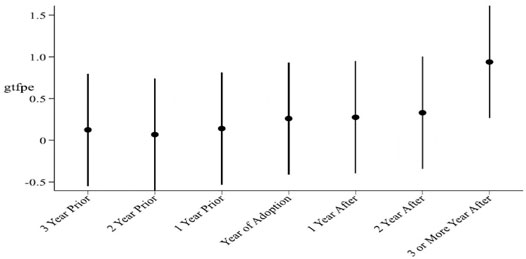
FIGURE 2. Parallel trend test. Note: The X-axis represents the time before and after implementing the emission trading system. The Year of Adoption represents the year in which the emission trading system is implemented. The first 3 years are expressed in Prior, and the last 3 years and above are described in After.
4.4 Overcoming Endogenous Problems: the Instrumental Variable Method
The selection of pilot cities may be affected by other potential factors, which may interfere with the estimation results of the DID method and affect the accuracy of the results. Therefore, based on the study of Cai et al. (2016), the instrumental variable method is used to overcome the influence of endogenous problems as much as possible. Specifically, based on Shi and Li (2020), the air circulation coefficient is selected as the instrumental variable and included in the pilot cities in the emission trading system. Moreover, meteorological and geographical conditions determine the air circulation coefficient, which can accord with the exogenous hypothesis of instrumental variables.
The estimation results of the instrumental variables are shown in Table 4. The instrumental variable is denoted by iv, which represents the natural logarithm of the annual mean value of the air circulation coefficient of the sample city. In the first stage of regression, the coefficients of the interaction item iv × post of instrumental variables and time variables are significant, and the F-values are greater than 10. The results show that the instrumental variables accord with the correlation conditions. In the second stage of regression, the interaction term experiment × post is still significant, indicating that the emission trading system can still significantly improve green total factor energy efficiency after eliminating endogenous problems.
4.5 Robustness Test
4.5.1 Placebo Test
In order to further eliminate the influence of other unknown factors and ensure the accuracy of the research conclusions, a placebo test is used. Specifically, this study conducted 500 samples in all 265 cities and randomly selected 100 cities as the virtual experimental group each time and the other cities as the control group for regression. The kernel density distribution plot of the explained variables in Figure 3 shows that the absolute value t of most sampling estimation coefficients is within 2, and the p-value is greater than 0.1, indicating that the emission trading system has no significant effect on these 500 random samples. Therefore, the conclusion of this study can pass the placebo test.
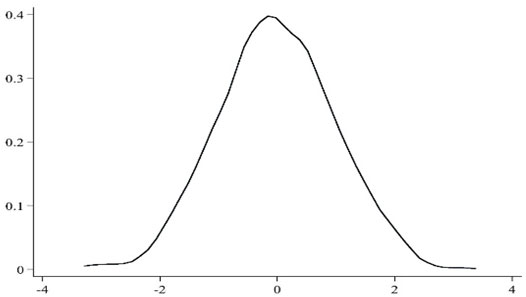
FIGURE 3. The x-axis represents the t value of the ‘experiment × post’ coefficient, Y-axis represents its corresponding p-value.
4.5.2 Propensity Score Matching-Difference-in-Difference Estimation
The sample of this study covers 265 cities across the country. There are significant differences among the sample cities, which may affect the consistency of the estimator and leads to biased results. Therefore, the propensity score matching method (PSM) is used to match the cities of the experimental group and the control group with the control variables as the identification characteristics of the sample points used for regression. The findings in Table 5 show that the emission trading system significantly improves the green total factor energy efficiency of the pilot cities, indicating that the conclusions obtained in this study are still robust.
4.6 Heterogeneity Analysis: Heterogeneous Impact of Different Types of Resource-Based Cities
The total factor energy efficiency of most resource-based cities is in a state of nonefficiency, and there are significant differences among different types of resource-based cities. China’s sustainable development plan for resource-based cities (2013–2020) has established 262 resource-based cities that are divided into four types, growing, mature, declining, and renewable resource-based cities, according to the abundance of resources. Table 6 reports the results of the heterogeneous impact of the emission trading system on different types of resource-based cities from the perspective of green total factor energy efficiency.
The emission trading system has the most pronounced effect on improving the green total factor energy efficiency in the growing resource-based cities, followed by renewable and mature types. It has no significant impact on the declining types. The possible reason is that in growing resource-based cities, the pressure on environmental protection is slight, and there is a net inflow of labor and capital. As a result, the energy exploitation and total factor energy efficiency are mostly increasing. After experiencing the development stage of high pollution and high energy consumption, renewable resource-based cities have become more aware of cleaner production technology and energy efficiency. The energy utilization and pollution emission of mature resource-based cities are relatively stable. Meanwhile, the technical difference between enterprises is relatively small, resulting in less impact of emission trading system on improving green all factor energy efficiency. With the gradual depletion of energy resources, the production costs of various enterprises increase, and the outflow of labor and capital, resulting in generally low investment in cleaner production technology, and the emission trading market is likely to be stagnant. Therefore, the emission trading system has no significant impact on the green all factor energy efficiency of declining resource-based cities.
5 Research Conclusion and Policy Implications
5.1 Research Conclusion
This study considers 265 cities from 2003 to 2017 as a research sample to investigate the impact of market-oriented environmental regulation tools, especially the emission right system, on green total factor energy efficiency using the DID model. The main conclusions are as follows: after a series of robustness tests such as the parallel trend test, instrumental variable method, random sampling simulation test of the experimental group, and PSM method, it is found that the emission trading system significantly improves the green all factor energy efficiency. It is found from heterogeneity analysis that the emission trading system is generally conducive to improving energy efficiency in resource-based cities. The improvement effect of green all factor energy efficiency on the emission trading system is of growing type, renewable type, and mature type from large to small, and the impact on declining type is not significant.
5.2 Policy Implications
From the new perspective of green total factor energy efficiency, this study analyzes in-depth the impact of market-oriented environmental regulation tools, especially on the emission trading system. Additionally, this research discusses the heterogeneity of resource-based cities, providing a targeted empirical basis and policy enlightenment for further improving the emission trading system’s energy conservation and consumption reduction as well as the green development effect. Thus, the following policy implications are desirable based on the empirical results.
Market-oriented environmental regulation tools should fully play their role in market-oriented attributes and provide good market trading platforms, intermediary organizations, and legal support for trading subjects, especially in dealing with the synergy between the government and the market in implementing the trading system. The government should not intervene in implementing the trading system but provide necessary trading market supervision, especially paying attention to the design of the cross-regional trading system. At the same time, it should create a good business environment and encourage social capital to participate in transactions. The government should strengthen environmental administrative supervision, increase the monitoring frequency and intensity of pollution sources, and ensure the accurate collection of emission information.
The key link for improving the green total factor energy efficiency is to build an enterprise R&D innovation system. For cities with coal as the main energy consumption structure, we should highlight the R&D investment or technology introduction of clean coal utilization technology by the innovation fund and gradually reduce the proportion of coal consumption in energy consumption. Meanwhile, for cities with advantages in renewable energy development, fiscal, tax, and financial policies supporting the development of emerging industries can be comprehensively applied to provide necessary policy support for the renewable energy power generation industry. The focus should be on the development of high-tech industries and we should strive to eliminate the dependence of economic development on high energy consumption and high pollution industries to improve the green all factor energy efficiency.
The market-oriented environmental regulation tools have a heterogeneous impact on the green total factor energy efficiency. Different pilot cities have significant differences in their economic development, innovation level, energy structure, and other factors, and the implementation effects of environmental regulation tools are significantly different. Therefore, each transaction pilot city cannot adopt the same standard when formulating the policies. It should carry out the transaction pilot construction “according to local conditions” to recognize its particularity to improve the efficiency of green development.
The improvement of green total factor energy efficiency has always been a key area of green transformation and development of the industry. Although the current market-oriented environmental regulation tools had a positive impact, steps to improve the enthusiasm of the main participants in the trading market to a greater extent should be paid more in-depth attention. Including how to build a cross-regional trading market and overcoming the energy rebound effect are important theoretical and practical issues worthy of discussion in the future.
Data Availability Statement
The raw data supporting the conclusion of this article will be made available by the authors, without undue reservation.
Author Contributions
XW: Conceptualization, data curation, formal analysis, visualization, writing—original draft. ST: writing—original draft and editing. MA: supervision, writing—review, and editing. YB: writing—review, project administration, and editing.
Funding
This work was supported by the Social Science Foundation of Shandong Province (Grant No. 20CSDJ42).
Conflict of Interest
The authors declare that the research was conducted in the absence of any commercial or financial relationships that could be construed as a potential conflict of interest.
Publisher’s Note
All claims expressed in this article are solely those of the authors and do not necessarily represent those of their affiliated organizations, or those of the publisher, the editors, and the reviewers. Any product that may be evaluated in this article, or claim that may be made by its manufacturer, is not guaranteed or endorsed by the publisher.
References
Albrizio, S., Kozluk, T., and Zipperer, V. (2017). Environmental Policies and Productivity Growth: Evidence across Industries and Firms. J. Environ. Econ. Manag. 81, 209–226. doi:10.1016/j.jeem.2016.06.002
Anderson, B., and Di Maria, C. (2010). Abatement and Allocation in the Pilot Phase of the EU ETS. Environmental and Resource Economics 48, 83–103. doi:10.1007/s10640-010-9399-9
Betsill, M., and Hoffmann, M. J. (2011). The Contours of "Cap and Trade": The Evolution of Emissions Trading Systems for Greenhouse Gases. Rev. Pol. Res. 28, 83–106. doi:10.1111/j.1541-1338.2010.00480.x
Cai, X., Lu, Y., Wu, M., and Yu, L. (2016). Does Environmental Regulation Drive Away Inbound Foreign Direct Investment? Evidence from a Quasi-Natural Experiment in China. J. Dev. Econ. 123, 73–85. doi:10.1016/j.jdeveco.2016.08.003
Calel, R., and Dechezleprêtre, A. (2016). Environmental Policy and Directed Technological Change: Evidence from the European Carbon Market. Rev. Econ. Stat. 98, 173–191. doi:10.1162/REST_a_00470
Chen, Z., and Chen, Q. Y. (2019). Energy Efficiency of Chinese Firms: Heterogeneity, Influencing Factors and Policy Implications. China Ind. Econ. 12, 78–95. doi:10.19581/j.cnki.ciejournal.2019.12.00510.1007/s12053-018-9687-8
Cheng, B., Dai, H., Wang, P., Zhao, D., and Masui, T. (2015). Impacts of Carbon Trading Scheme on Air Pollutant Emissions in Guangdong Province of China. Energ. Sustain. Dev. 27, 174–185. doi:10.1016/j.esd.2015.06.001
Feng, F., and Ye, A. Z. (2015). Does the Rebound Effect Exacerbate the Increasing of China's Total Energy Consumption? J. Quantitative Tech. Econ. 32, 104–119. doi:10.13653/j.cnki.jqte.2015.08.007
Gray, W. B., and Shadbegian, R. J. (2003). Plant Vintage, Technology, and Environmental Regulation Journal of Environmental Economy Management 46, 384–402. doi:10.1016/S0095-0696(03)00031-7
Hamamoto, M. (2006). Environmental Regulation and the Productivity of Japanese Manufacturing Industries. Resource and Energy Economics 28, 299–312. doi:10.1016/j.reseneeco.2005.11.001
Hancevic, P. I. (2016). Environmental Regulation and Productivity: The Case of Electricity Generation under the CAAA-1990. Energ. Econ. 60, 131–143. doi:10.1016/j.eneco.2016.09.022
Hering, L., and Poncet, S. (2014). Environmental Policy and Exports: Evidence from Chinese Cities. J. Environ. Econ. Manag. 68, 296–318. doi:10.1016/j.jeem.2014.06.005
Khan, I., Hou, F., Zakari, A., Tawiah, V., and Ali, S. A. (2021). Energy Use and Urbanization as Determinants of China's Environmental Quality: Prospects of the Paris Climate Agreement. J. Environ. Plann. Manag., 1–24. doi:10.1080/09640568.2021.1972797
Khan, I., Zakari, A., Zhang, J., Dagar, V., and Singh, S. (2022). A Study of Trilemma Energy Balance, Clean Energy Transitions, and Economic Expansion in the Midst of Environmental Sustainability: New Insights from Three Trilemma Leadership. Energy 248, 123619. doi:10.1016/j.energy.2022.123619
Lambie, N. R. (2010). Understanding the Effect of an Emissions Trading Scheme on Electricity Generator Investment and Retirement Behaviour: The Proposed Carbon Pollution Reduction Scheme. Aust. J. Agric. Resource Econ. 54, 203–217. doi:10.1111/j.1467-8489.2010.00486.x
Lanoie, P., Patry, M., and Lajeunesse, P. (2008). Environmental Regulation and Productivity: Testing the Porter Hypothesis. Journal of Productivity Analysis 30, 121–128. doi:10.1007/S11123-008-0108-4
Li, B., and Chen, C. N. (2016). An Empirical Test of the Impact of Heterogeneous Environmental Regulation on China's Industrial Energy Efficiency. Stat. Decis. 03, 129–132. doi:10.13546/j.cnki.tjyjc.2016.03.035
Li, Y. Y., and Wen, Y. F. (2016). A Study on the Efficiency of Emission Trading Policy in China: Empirical Analysis Based on Natural experiment. Economist 05, 19–28. doi:10.16158/j.cnki.51-1312/f.2016.05.004
Lin, L., and Sun, W. (2016). Location Choice of FDI Firms and Environmental Regulation Reforms in China. J. Regul. Econ. 50, 207–232. doi:10.1007/s11149-016-9303-9
Lu, S., Zhang, W. Z., and Li, J. M. (2020). Influence of Environmental Regulations on Industrial Transformation of Resource-Based Cities in the Yellow River Basin under Resource Endowment. Bull. Chin. Acad. Sci. 35, 73–85. doi:10.16418/j.issn.1000-3045.20200107004
Porter, M. E., and Linde, C. v. d. (1995). Toward a New Conception of the Environment-Competitiveness Relationship. J. Econ. Perspect. 9, 97–118. doi:10.1257/jep.9.4.97
Ren, S. G., Zheng, J. J., Liu, D. H., and Chen, X. H. (2019). Does Emissions Trading System Improve Firm's Total Factor Productivity: Evidence from Chinese Listed Companies. China Ind. Econ. 05, 5–23. doi:10.19581/j.cnki.ciejournal.2019.05.001
Rubashkina, Y., Galeotti, M., and Verdolini, E. (2015). Environmental Regulation and Competitiveness: Empirical Evidence on the Porter Hypothesis from European Manufacturing Sectors. Energy Policy 83, 288–300. doi:10.1016/j.enpol.2015.02.014
Schleich, J., and Betz, R. (2004). EU Emissions Trading and Transaction Costs for Small and Medium Sized Companies. Intereconomics 39, 121–123. doi:10.1007/BF02933576
Schleich, J., Rogge, K., and Betz, R. (2009). Incentives for Energy Efficiency in the EU Emissions Trading Scheme. Energy Efficiency 2, 37–67. doi:10.1007/s12053-008-9029-3
Shi, D., and Li, S. L. (2020). Emissions Trading System and Energy Use Efficiency: Measurements and Empirical Evidence for Cities at and above the Prefecture Level. China Ind. Econ. 09, 5–23. doi:10.19581/j.cnki.ciejournal.2020.09.001
Stein, L. A. (2019). The Legal and Economic Bases for an Emissions Trading Scheme. Monash University. Journal contribution. doi:10.26180/5db7fd15ef381
Tang, L., Wu, J., Yu, L., and Bao, Q. (2015). Carbon Emissions Trading Scheme Exploration in China: A Multi-Agent-Based Model. Energy Policy 81, 152–169. doi:10.1016/j.enpol.2015.02.032
Tang, M., Li, X., Zhang, Y., Wu, Y., and Wu, B. (2020). From Command-And-Control to Market-Based Environmental Policies: Optimal Transition Timing and China's Heterogeneous Environmental Effectiveness. Econ. Model. 90, 1–10. doi:10.1016/j.econmod.2020.04.021
Wang, H., and Dong, Z. Q. (2019). Local-Neighborhood Effect of Green Technology of Environmental Regulation. China Ind. Econ 01, 100–118. doi:10.19581/j.cnki.ciejournal.2019.01.006
Zhang, Y.-J., Peng, Y.-L., Ma, C.-Q., and Shen, B. (2017). Can Environmental Innovation Facilitate Carbon Emissions Reduction? Evidence from China. Energy Policy 100, 18–28. doi:10.1016/j.enpol.2016.10.005
Keywords: market-oriented environmental regulation tools, emission trading system, green total factor energy efficiency, difference-in-difference method, energy efficiency
Citation: Wang X, Tang S, Ahmad M and Bai Y (2022) Can Market-Oriented Environmental Regulation Tools Improve Green Total Factor Energy Efficiency? Analyzing the Emission Trading System. Front. Environ. Sci. 10:906921. doi: 10.3389/fenvs.2022.906921
Received: 29 March 2022; Accepted: 11 April 2022;
Published: 10 May 2022.
Edited by:
Muhlis Can, BETA Akademi-SSR Lab, TurkeyReviewed by:
Irfan Khan, Beijing Institute of Technology, ChinaZhongzheng Fang, Anyang University, South Korea
Copyright © 2022 Wang, Tang, Ahmad and Bai. This is an open-access article distributed under the terms of the Creative Commons Attribution License (CC BY). The use, distribution or reproduction in other forums is permitted, provided the original author(s) and the copyright owner(s) are credited and that the original publication in this journal is cited, in accordance with accepted academic practice. No use, distribution or reproduction is permitted which does not comply with these terms.
*Correspondence: Yang Bai, YjE5ODcxNnlAaG90bWFpbC5jb20=
 Xingshuai Wang
Xingshuai Wang Shida Tang2
Shida Tang2 Mahmood Ahmad
Mahmood Ahmad

